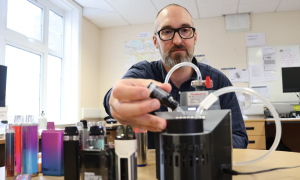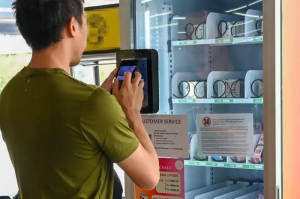E-cigarette advocates and tobacco harm reduction advocates, as well as the FDA, have long promoted a 50% reduction in cigarette smoking as a positive outcome when assessing the value of e-cigarettes (recent example). The FDA’s use of this benchmark is particularly surprising because in 2021 FDA scientists published a meta-analysis of the effects of smokers reducing cigarette consumption found no all-cause mortality benefit.
Ahmad Husari and colleagues have added important experimental evidence reinforcing the fact that replacing 50% of cigarettes with e-cigarettes or a heated tobacco product (Philip Morris’ IQOS) doesn’t provide short-term benefits in terms of lung disease. Their paper “The Substitution of Fifty Percent of Combustible Tobacco Smoke Exposure With Either Electronic Cigarettes or Heated tobacco Products Did Not Attenuate Acute Lung Injury in an Animal Model” reports experiments in which they exposed mice to clean air, cigarette smoke, and e-cigarette and IQOS aerosol for 3 hours in the morning and 3 hours in the afternoon for a week. Most relevant, they also replaced the afternoon cigarette smoke sessions with e-cigarette or IQOS aerosol, modeling a situation in which someone replaced half their cigarettes with one of the aerosol products.
They found no difference between the 100% cigarette smoke mice and the mice where half the smoke was replaced with one of the aerosol products for measures of leaky lung cells, measures of inflammation, reactive oxygen species and lung cell death. (E-cigarettes or HTP alone weren’t as bad a smoking.) So, a 50% reduction in smoking accomplished by replacing the cigarettes with aerosol products did not provide any benefit.
Indeed, this experiment probably underestimates the risk of dual use (using both cigarettes and e-cigarettes or HTP) because many people who dual use do not reduce cigarette consumption, resulting in an increase in toxicant exposure.
The authors summed up the implications of their research:
… the findings of our study signal against dual use and the associated benefit or risk reduction. The notion that dual use is a reduced-risk alternative to quitting combustible tobacco smoking is not supported by the findings of this study.
….
that substituting fifty percent of CS [cigarette smoke] exposure with ECIG or HTP did not reduce lung injury. These results suggest a potentially grave misunderstanding by cigarette users that partially substituting cigarette use with ECIG or HTP use can reduce health risks. [emphasis added]
Researchers and regulators — including FDA — need to stop using a 50% reduction in smoking among dual users as a positive outcome.
Here is the abstract:
Background: To reduce the harmful health effects of combustible cigarette smoke (CS), some (CS) users attempt to substitute CS with electronic cigarettes (ECIG) and/or heated tobacco products (HTP). In this animal study, we evaluated the acute effects of substituting CS consumption with ECIG or HTP thus mimicking the dual users’ approach, on the lungs of a mouse model.
Methods: C57BL/6 mice were divided into Control, ECIG, HTP, CS, ECIG + CS, HTP + CS, and HTP + ECIG groups. Animals were exposed for 3 hours in AM and PM sessions to either air, CS, ECIG, or HTP for seven days. Lung injury was assessed by: wet to dry (W/D) ratio, albumin concentration in bronchoalveolar lavage fluid, expression of IL-1β, IL-6, and TNF-α, histopathology examination, reactive oxygen species (ROS) production, and assessment of cellular apoptosis.
Results: W/D ratio was significantly increased in mice exposed to CS only. Albumin leak and expression of IL-1β, IL-6, and TNF-a were elevated in CS, ECIG + CS, and HTP + CS. Histological examination revealed significant inflammatory cells infiltration, as well as collagen deposit in CS, ECIG + CS, HTP + CS. ROS production was significantly increased in CS, ECIG + CS, HTP + CS. Finally, cell death was also significantly increased in CS, ECIG + CS, and HTP + CS.
Conclusion: In this animal model, substituting 50% of daily CS exposure by either ECIG or HTP exposure did not result in significant attenuation of acute lung injury.
Full Citation: Husari A, El-Harakeh M, Shihadeh A, Daou MAZ, Bitar H, Karaoghlanian N, Zaatari G, El-Sabban M. The Substitution of Fifty Percent of Combustible Tobacco Smoke Exposure With Either Electronic Cigarettes or Heated tobacco Products Did Not Attenuate Acute Lung Injury in an Animal Model. Nicotine Tob Res. 2023 Jun 9;25(7):1361-1368. doi: 10.1093/ntr/ntad045.
Source: Profglantz










